Chapter 4a: Communicating Waste Management Effectively
“The greatest threat to our planet is the belief that someone else will save it.”
-Robert Swan
Objectives
By the end of this chapter, students will be able to:
- Identify and describe the different types of waste
- Examine the factors influencing waste production and its ramifications
- Apply effective communication strategies for promoting sustainable waste management practices within businesses and to customers
Introduction
Understanding the different kinds of waste is essential for professional communicators to be able to explain how an organization impacts the environment. By communicating types of waste and the efforts to manage them ethically, organizations can enhance their transparency, build trust with stakeholders, and promote sustainability. This chapter will define the different types of waste, explain each type’s impact on the environment, and then describe best practices for communicating how businesses handle these issues effectively.
Waste Generation
Virtually every resident, organization, and human activity in the U.S. generates some type of waste. Various kinds of waste are produced, including municipal solid waste, hazardous waste, industrial non-hazardous waste, agricultural and animal waste, medical waste, radioactive waste, construction and demolition debris, extraction and mining waste, oil and gas production waste, fossil fuel combustion waste, and sewage sludge. The volume of waste generated is influenced by economic activity, consumption patterns, and population growth. Among industrialized countries, the U.S. ranks as one of the highest generators of municipal solid waste per capita. [1]
Municipal solid waste (MSW) generated overall in 2018 was 292.4 million tons, or 4.9 pounds per person daily. About 25 million tons were composted and 69 million tons were recycled out of the MSW produced. With over 94 million tons of MSW recycled and composted combined, the rate of recycling and composting was 32.1 percent. Other approaches handled another 17.7 million tons of food. Furthermore, about 146 million tons of MSW (50 percent) were landfilled and almost 35 million tons of MSW (11.8 percent) were combusted with energy recovery (EPA, 2023).
Waste accumulation is one of the top environmental concerns of Europeans (it ranks first in Lithuania). In addition, every EU person produces 500 kg of municipal garbage year on average (Statista, 2021). Over the last 15 years, Lithuania’s per capita municipal garbage has climbed from 405 kg to 480 kg (Eurostat, 2023a). Regretfully, the proportion of recycled garbage has been steadily declining in recent years, only 44.3% in 2021 (Eurostat, 2023b).
These two trends are damaging as the EU’s residual municipal waste target has not yet been met. A lack of knowledge and an uninformed acceptance of the idea of what waste is would often impede proactive public involvement. Effective and transparent communication is essential for integrating diverse viewpoints and methods of thinking based on varying levels of experience and knowledge amongst waste management (WM) stakeholders. People who engage in active communication are more likely to talk about environmental concerns, which may lead to an effective commitment (such as emotional engagement) and influence people’s behavior as a whole. 2 Below is Laurynaitytė and Pašėraitė (2023)’s visual on guidelines for communicating the value of waste management through website content.
The left side is a circle that says “keep” and inside it is “attention to communication,” “aim to inform customers,” and interactive content forms.” On the right is a circle that says “improve” and below is “by reducing” and “by increasing.” Under “improve by reducing,” there is a box that says “uniformity,” pointing to “consistent effort and development” and the other arrow points to “relevant and unique communication.” Another box under “improve by reducing” says “focus on attributes and features.” It points to “knowledge about customer preferences” and “a balance between value dimensions and elements.” The last box says “improve by reducing” then “number of brick-type content unites” pointing to “by increasing the number of feather-type content units.”
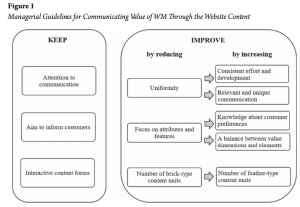
Effective communication strategies play a pivotal role in promoting sustainable waste management practices. The generation of waste often signifies inefficient use of materials, such as supplying over demand, issues with technology, or miscommunication within an organization. Monitoring trends in the quantity, composition, and impacts of waste provides insights into how efficiently materials and resources are used and reused. The integration of strategic planning with sustainability objectives in small businesses. By utilizing advanced technologies and advanced communication practices, businesses can enhance their sustainability efforts, minimize resource wastage, and strengthen stakeholder engagement. [3]To further understand how businesses can effectively address waste, the next section will define common types of waste, explore the environmental impacts of each type, and discuss strategies for optimal communication about waste management practices. This will provide a foundation for future chapters and activities on how businesses can communicate their current and future attempts to reduce their environmental footprint.
Types of Waste and Communication Techniques
Plastic Waste
Plastic waste comprises plastic bottles, bags, packaging, and other throwaway plastic objects. since of the material’s longevity and extensive usage, this sort of trash is regrettably also quite frequent since it is not readily biodegradable. [4] Biodegradable means the product can decay naturally without harming its environment. [5]
A concerning analysis from the Lawrence Berkeley National Laboratory (LBNL) verifies that the manufacture of plastics has a major role in contributing to climate change worldwide. If left uncontrolled, the plastics industry’s contribution to global climate change pollution is estimated by the report’s authors to quadruple by the middle of the 20th century, making up one-fifth of Earth’s remaining carbon budget. Using green electricity alone to decarbonize manufacturing is insufficient since plastics need up to 70% of fossil fuels as raw ingredients. The output of plastic has increased by nearly 22,000% in the previous 70 years. The fossil fuel industry’s attempt to maintain relevance has resulted in increasing single-use plastic items while many other sectors shift toward more sustainable fuel sources. [6]
To ethically communicate about plastic waste, businesses should highlight their efforts to reduce plastic usage and switch to biodegradable alternatives. Organizations should also promote recycling programs and educate the public about the environmental impact of plastic waste. Effective communication can include transparent reporting on the company’s plastic usage, initiatives to reduce single-use plastics, and partnerships with recycling organizations to ensure proper plastic waste management. Below is an image of a 100% biodegradable grocery bag:
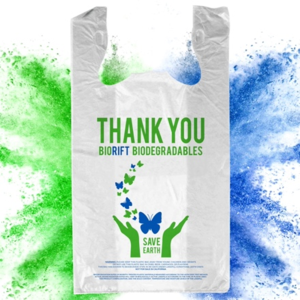
Paper Waste
From 2010 to 2060, the global consumption of pulp and paper is expected to double. The same will the amount of paper waste. An increased paper production will also add further to the pressure on the world’s forests that are already in a critical state – and constantly getting worse. [9]
Businesses can communicate their paper waste management by discussing initiatives to decrease paper consumption, such as implementing digital solutions and encouraging double-sided printing. Additionally, promoting the recycling of paper products and using recycled paper in operations can be effective. Sharing success stories and metrics about reduced paper waste can help engage stakeholders and demonstrate the company’s commitment to sustainability. Below is an image of labels that a product may have to show that it is recyclable, made of 100% recycled fiber, or a percentage of recycled fiber:

Related to paper and plastic waste, packaging waste includes glass and metal materials used for packaging products. This type of waste is a major contributor to overall waste generation. Businesses should discuss efforts to reduce packaging, use sustainable materials, and promote the recycling of packaging waste. Communication can involve highlighting packaging innovations, providing information on how consumers can recycle packaging, and reporting on the impact of packaging reduction initiatives. [11]
The following are steps you can take if you are interested in reducing paper and plastic waste:
- Be a conscious consumer and buy “100% post-consumer waste recycled” or products with the least paper or plastic packaging.
- Buy recycled materials or materials that came from sustainable managed forests/facilities.
- Recycle all your paper and plastic materials in bins that take recycled goods.
- In the office, reuse paper and plastic bottles/cartons. This small effort reduces paper waste by 50%.
- Avoid printing or purchasing anymore unless really needed.
- Use email instead of paper when communicating with clients and customers.
- Reduce the use of paper cups and disposable paper plates by keeping reusable items in the office pantry.
- Encourage your officemates and friends to recycle their paper and plastic by adding recycling bins.
- Encourage businesses that follow environment friendly practices.
- Take advantage of the latest technologies like tablets, computers, and smart phones to keep your files and notes.[12]
Electronic Waste (E-Waste).
While there are many of alternatives to paper, the rise in electronic devices also makes it necessary to communicate proper disposal methods for this kind of waste. E-waste refers to the disposing of electronics including cell phones, batteries, computers, TVs, and more. Because harmful compounds are often discovered in electronic equipment and may affect human health and the environment if improperly handled, this form of waste is especially concerning. [13]
Materials found in electronic gadgets, such as beryllium, cadmium, and lead, are very hazardous to both human health and the environment. When e-waste ends up in landfills, the hazardous elements drain into the earth by dissolving into a sludge that seeps through the landfill’s bottom. Large hazardous dissolved pools caused by massive volumes of e-waste become a problem when they seep into the surrounding soil and water bodies, endangering public health.
In 2022, the UN Institute for Training and Research (UNITAR) released its most recent Global E-garbage Monitor, which showed that the globe produced a record 62 billion kilos of electronic garbage, or e-waste. This is to an average of 7.8 kg per people per year and an 82% increase from 2010. Only 22.3% of the entire amount of electronic garbage created in 2022 was officially collected and recycled in an ecologically responsible way. That is a nearly five-fold increase in e-waste creation compared to the growth in organized recycling. By comparison, e-waste recycling is a multifaceted process that includes physical sorting, dismantling and shredding to eliminate hazardous materials, inspecting electronic equipment for working components, and separating metals from non-magnetic materials. Expert laborers are essential to guaranteeing the secure and effective functioning of the recycling procedure. While non-magnetic minerals are separated using water based on their respective densities, valuable metals are separated using magnets and mechanical processing. To recover any valuable elements that may still be present in the plastic components, a last inspection is carried out before the recycled materials are sold. [14]
For instance, photocopier toner is very flammable and explosive and has the potential to blow up processing equipment if it is shredded. It should be taken apart considering that so many items may be used as fuel sources, including its plastic. Recycling a photocopier’s toner is a crucial operation that has to be completed by qualified people.
Metals
Metals, the important components that make the e-waste recycling a viable business, will separate after other waste is shredded. This particular session does not need manual sorting, in contrast to the others. Water is then used to further sort the waste. Almost everything that is still non-magnetic at this stage will travel through another water-filled machine where materials with low relative densities, like plastic, will float while things with high relative densities, like glass, would sink. Finally, check to see if any priceless pieces are still stuck to the plastic before recycled products are put on sale. [15] Below is an image of e-waste and its process:
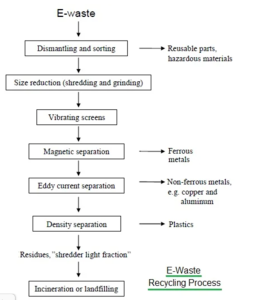
Businesses should communicate the importance of proper e-waste disposal and recycling by providing information on take-back programs and recycling events. Educating consumers about the hazards of improper e-waste disposal and the benefits of recycling can foster more responsible behaviors and support the company’s environmental goals.
Hazardous Waste
Hazardous waste includes paints, batteries, solvents, chemicals, and other things that might be harmful to the environment or human health are examples of. Hazardous wastes are tightly monitored because of their possible risks. Medical waste includes pharmaceuticals, biohazardous items from healthcare institutions, and old medical supplies. To avoid contaminating the environment and posing health hazards, this waste has to be handled and disposed of carefully. Industrial waste includes sludge, chemicals, scrap metal, and other of byproducts from manufacturing operations. Construction and destruction waste come from building sites, such as bricks, metals, concrete, and wood. According to the United States Environmental Protection Agency (2019), this kind of waste may be large and often includes recyclable components. Businesses should inform the public about proper disposal methods, compliance with health regulations, and efforts to minimize medical waste generation. Communication can include educational campaigns about the dangers of improper medical waste disposal, partnerships with medical waste disposal services, and reporting on waste reduction achievements in healthcare settings. [18]
Other types of waste
Below are types of waste that will be described in more detail in future chapters:
Oil and Gas Production Waste
Oil and Gas Production Waste can pose significant environmental risks if not properly managed. [19] Businesses should highlight measures taken to safely manage and dispose of these wastes and efforts to minimize their environmental impact. Communication can involve detailing safety protocols, reporting on waste management performance, and engaging with stakeholders about ongoing efforts to improve sustainability in the oil and gas sector. However, oil industries have unique ways of expressing their CSR activities, often focusing on maintaining a positive image while neglecting the actual environmental impacts. [20]
Agricultural Waste
Agricultural Waste consists of crop residues, animal manure, and other organic waste from farming activities. Proper management of this waste can provide environmental benefits, such as improving soil health and reducing greenhouse gas emissions.[21] Businesses should share practices for composting agricultural waste, using it as biofuel, and other sustainable waste management methods. Effective communication can include educational materials for farmers and reporting on the environmental benefits achieved. Another chapter will also delve into the issue of utilizing animals for work, testing animals for products, and whether or not meat is a more sustainable alternative than plant-based foods.
Food Waste
Food Waste consists of expired, spoiled, or unused food products from various sources, including cafeterias, restaurants, and food production facilities. This type of waste is significant not only because of the resources used to produce the food but also due to its potential environmental impact when decomposing in landfills.[22] Businesses should share strategies for reducing food waste, such as implementing donation programs, composting, and improving inventory management to minimize overproduction. Communicating these efforts can involve publicizing partnerships with local food banks, sharing composting guidelines, and reporting on the reduction of food waste metrics. Another chapter will discuss water waste and greenwashing in food and beverage industries.
Water Waste
Water Waste, which also includes aquatic pollution, in business practices includes the overuse of freshwater resources and contamination of water systems through runoff, landfill spills, or industrial discharge. Many industries, especially in manufacturing and agriculture, contribute to water waste and pollution, which harms aquatic ecosystems and affects clean water access globally. Businesses can reduce their water footprint by improving wastewater treatment, adopting closed-loop systems, and communicating transparently about water conservation efforts. Public outreach campaigns, partnerships with water stewardship organizations, and clear labeling about water-saving processes help educate consumers and stakeholders about responsible water use. This is a summary of another chapter which will go into more detail.
Textile Waste
Textile Waste consists of discarded clothing, fabrics, and other textile products. This waste can be generated at various stages, from manufacturing to post-consumer disposal. Businesses should promote textile recycling programs, sustainable fashion initiatives, and efforts to reduce textile waste through donations and upcycling. Effective communication strategies can include publicizing textile collection events, partnering with organizations that recycle or repurpose textiles, and educating consumers about the environmental benefits of extending the life cycle of their clothing. Another chapter will explore greenwashing in fashion industries in more detail. [23]
Health and Beauty Product Waste
Health and Beauty Product Waste contributes to environmental damage through ingredients like microplastics, palm oil derivatives, and chemical residues from shampoos, lotions, and cosmetics. These substances often enter water systems through household drains, harming marine life and polluting ecosystems. Packaging waste, especially single-use plastics, adds to landfill overflow and environmental degradation. Businesses in this sector can reduce their impact by reformulating products with biodegradable ingredients, offering refillable packaging, and adopting eco-certifications. Communicating these efforts through sustainable branding, ingredient transparency, and consumer education campaigns helps build trust and encourage more mindful consumption. See the last chapter to explore this topic in more detail.
Is All Waste Hazardous?
All trash has a broad range of consequences, which are determined by the materials or chemicals present and the methods used to handle them. The management of garbage may lead to waste and chemicals entering the environment, even if there is no evidence to directly correlate trends in waste with consequences on human health and the ecosystem. Because hazardous waste is by definition potentially harmful to both human health and the environment, it is subject to stringent regulations. Hazardous waste creation and handling have the potential to pollute land, air, and water as well. An item must first be a solid waste in order to be classed as a hazardous waste. [24]
Chemical wastes may or may not be classified as hazardous waste, but they are dangerous substances according to information provided to the EPA’s Toxics Release Inventory (TRI). The basis for TRI reporting is the application of chemicals, not the nature of the wastes produced. The information may be used as a starting point to assess the possibility of human exposure to TRI chemicals and if their releases may represent dangers to human health and the environment, even though the amount of TRI chemicals released into the air, water, or land does not indicate their health concerns. [25]
Landfills for municipal solid waste account for 15.5% of methane emissions linked to human activity in the United States in 2021, making them the third-largest source of emissions. Among the many gases other than carbon dioxide that cause global warming is methane. When wastes break down, methane gas is generated, and emissions depend on the quantity and composition of the wastes as well as the location, layout, and operations of the management facility. The EPA is interested in this because recycling and altering product use may have an impact on gas emissions. For instance, by lowering the need to gather new raw materials, more recycling of municipal solid waste conserves natural resources, lowers the quantity of garbage dumped in landfills, and prevents contamination.[26]
The energy and GHG benefits are calculated using the Waste Reduction Model (WARM) methodology. The WARM technique was used to determine the energy and greenhouse gas advantages of recycling, composting, burning with energy recovery, and landfilling, as shown in the table below. The estimations show the advantages of not landfilling materials as well as the environmental benefits of recycling, composting, and burning for energy recovery. The figures included in parenthesis indicate a decrease in greenhouse gas emissions or automobile use, hence signifying advantages for the environment. [27]
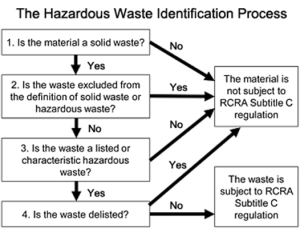
One of the many advantages of recycling hazardous trash is that it uses fewer raw resources and requires less garbage to be processed and disposed of. On the other hand, storing such items incorrectly might result in leaks, spills, fires, and contaminated drinking water and soil. The EPA created rules to guarantee recycling would be done safely in order to promote hazardous waste recycling while safeguarding public health and the environment. [28]
Waste Management Strategies
EPA continues to assess the waste hierarchy to see whether any adjustments should be made based on recent statistics and information. Below is an inverted pyramid with “source reduction and reuse” on top, then “recycling/composting,” “energy recovery,” and then “treatment and disposal” on the bottom.
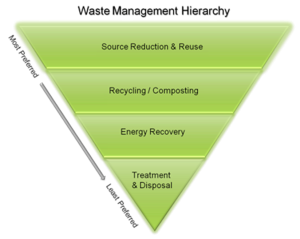
While traditional sustainability focuses on minimizing negative impacts (e.g., reducing waste, lowering emissions), regenerative approaches aim for a net positive impact. This means the business’s operations and products actually enhance the environment and society. Regenerative in business sustainability shifts the goal from simply “sustaining” a current, often degraded, state to actively “regenerating” and enhancing the health and vitality of the planet and its inhabitants. Regenerative agriculture, businesses adopting circular economy models that regenerate materials, and companies actively involved in reforestation or ecosystem restoration efforts are common examples. [29]
Effective Communication Strategies in Other Countries
Effective communication strategies are essential for promoting sustainable waste management practices within businesses. In Vietnam, businesses have adopted green marketing strategies to reduce waste and promote sustainability. Effective communication not only enhances a business’s public image but also influences consumer behavior towards more sustainable choices. [30]
Similarly, in Gweru, Zimbabwe, Maviya and Simbanegavi (2023) highlight the importance of structured market systems and targeted communication strategies among street vendors. Their research demonstrates that clear communication between vendors and local authorities significantly improves waste management practices, illustrating the importance of tailored communication strategies for different business environments. [31]
Conclusion and Call to Action for Consumers Using Technology
Consumer behavior is critical to the success of sustainable waste management initiatives. By understanding the preferences and motivations of various consumer segments, businesses can tailor their products and communication strategies to encourage sustainable practices, thereby building stronger, more sustainable customer relationships. [32] Additionally, the digitalization of communication strategies can significantly enhance sustainability efforts across different industries. Digital communication methods allow firms to promote their sustainability efforts more effectively and engage with stakeholders in real-time, thus facilitating better waste management and sustainability outcomes. [33]
Businesspeople don’t get to define what waste is; the readers and listeners of their communications do. Reducing waste therefore starts with communications experts putting themselves in another’s shoes and seeing the matter from others’ perspectives. A small conversation may seem pointless as it takes time away from work, but others might believe it’s quite essential. Find out what is your audience’s current knowledge level about your product. What is the minimum they need or care about to make use of the knowledge? Where are they in their purchase, investment, or decision cycle? [34] The next chapter will put these theories into practice as we try to write about a policy on managing waste for a specific organization.
[1] United States Environmental Protection Agency. (2019). Construction and demolition debris. Retrieved from EPA
[2] Laurynaitytė, R., & Pašėraitė, A. (2023). Waste Management to Customers: Focus on Website Content. Organizations and Markets in Emerging Economies, 14(28), 326-346.
[3] Ali, H., & Ahmad, N. (2023). Strategic Planning for Economic Resurgence: Leveraging Graphene Circuits, CR Model, and Mobile Apps in Small Business Development. Retrieved from Read PDF
[4] United Nations Environment Programme. (2018). Single-use plastics: A roadmap for sustainability. Retrieved from UNEP
[5] biodegradable. (2024). https://dictionary.cambridge.org/us/dictionary/english/biodegradable
[6] Saylor, J. (2024, April 22). The Plastic-Climate Problem. Pacific Environment. https://www.pacificenvironment.org/the-plastic-climate-problem/?gad_source=1&gclid=CjwKCAjwtNi0BhA1EiwAWZaANPx0akNzmuIs7Z4VI9BxaCQximEJes7GnH63buwz0Jj9M7jVEeOMGRoCNQkQAvD_BwE
[7] T Shirt Grocery Bags Bulk – 100% Biodegradable & Eco Friendly – Reusable Supermarket Small Trash Bags – Extra Strong Thank You Plastic Shopping Handles – Recyclable For Dog & Cat Poop (1000 Count). Amazon. https://www.amazon.com/BioRift-Grocery-Count-Biodegradable-Plastic/dp/B08M61X6TB
[8] American Forest & Paper Association. (2020). Paper recycling. Retrieved from AF&PA.
[9] The World Counts. (n.d.). https://www.theworldcounts.com/stories/paper-waste-facts
[10] https://colorpageonline.com/printing/sustainable/
[11] Sustainable Packaging Coalition. (2020). The state of sustainable packaging. Retrieved from Sustainable Packaging Coalition
[12] What You Can Do to Reduce Plastic Waste | US EPA. (2024, April 22). US EPA. https://www.epa.gov/plastics/what-you-can-do-reduce-plastic-waste#:~:text=Reduce%20and%20Reuse,-The%20most%20effective&text=Think%20green%20before%20you%20shop,Lunch%20guide%20for%20more%20tips.
[13] United Nations University. (2020). The global e-waste monitor 2020. Retrieved from E-Waste Monitor
[14] CITATION MISSING
[15] Wu, T. L. (2024, March 21). What Is E-Waste Recycling and How Is it Done? | Earth.Org. Earth.Org. https://earth.org/what-is-e-waste-recycling/
[16] E-Waste management | Disposal methods,recycling,advantages. (n.d.). https://www.rfwireless-world.com/Articles/E-Waste-management-recycling-and-disposal.html
[17] World Health Organization. (2018). Health-care waste. Retrieved from WHO
[18] United States Environmental Protection Agency. (2020). Industrial waste. Retrieved from EPA
[19] United States Environmental Protection Agency. (2020). Management of oil and gas exploration and production waste. Retrieved from EPA
[20] Guenther, E., Hoppe, H., & Poser, C. (2006). Environmental Corporate Social Responsibility of Firms in the Mining and Oil and Gas Industries: Current Status Quo of Reporting Following GRI Guidelines. Greener Management International, 53, 7–25. http://www.jstor.org/stable/greemanainte.53.7
[21] Food and Agriculture Organization of the United Nations. (2020). Agricultural waste. Retrieved from FAO
[22] Food and Agriculture Organization of the United Nations. (2019). Food loss and waste. Retrieved from FAO
[23] Environmental Protection Agency. (2018). Advancing sustainable materials management: 2018 fact sheet. Retrieved from EPA
[24] United States Environmental Protection Agency. (2020). Hazardous waste. Retrieved from EPA
[25] Wastes | US EPA. (2024b, July 8). US EPA. https://www.epa.gov/report-environment/wastes
[26] Basic Information about Landfill Gas | US EPA. (2024, April 25). US EPA. https://www.epa.gov/lmop/basic-information-about-landfill-gas
[27] Documentation for Greenhouse Gas Emission and Energy Factors Used in the Waste Reduction Model (WARM). (2023). U.S. Environmental Protection Agency Office of Resource Conservation and Recovery. From https://www.epa.gov/system/files/documents/2023-12/warm-background_v16_dec.pdf
[28] Waste Reduction Model (WARM) | US EPA. (2024, June 7). US EPA. https://www.epa.gov/warm
[29] Marquis, C. (2024). How Regeneration Is Redefining Business. Stanford Social Innovation Review, 22(3), 58–66. https://doi.org/10.48558/D7PY-Q475
[30] Linh, N. T. N. (2023). Green Marketing Development Strategy in Vietnam. Retrieved from Read PDF
[31] Maviya, A., & Simbanegavi, Y. R. (2023). Analyzing the Implications of the Growing Street Vendor Population in Gweru, Zimbabwe: A Risk Assessment. Retrieved from Read PDF
[32] Wyrzykowska, B., & Rytko, A. (2024). Green Choices: A Comprehensive Review of Pro-Environmental Consumer Behaviors. Retrieved from Read PDF
[33] Tolentino-Zondervan, F., & DiVito, L. (2024). Sustainability Performance of Dutch Firms and the Role of Digitalization: The Case of Textile and Apparel Industry. Retrieved from Read HTML
[34] Malcolm, J. (2018, March 8). Lean Communication: Reducing Waste. https://www.linkedin.com/pulse/lean-communication-reducing-waste-jack-malcolm/